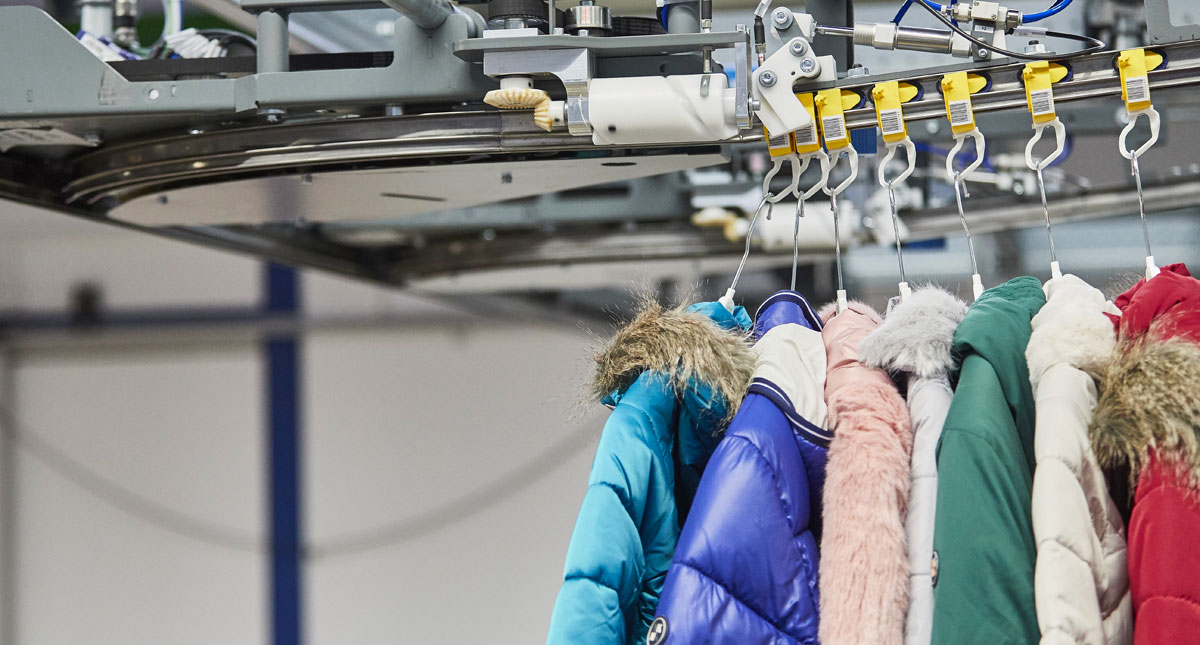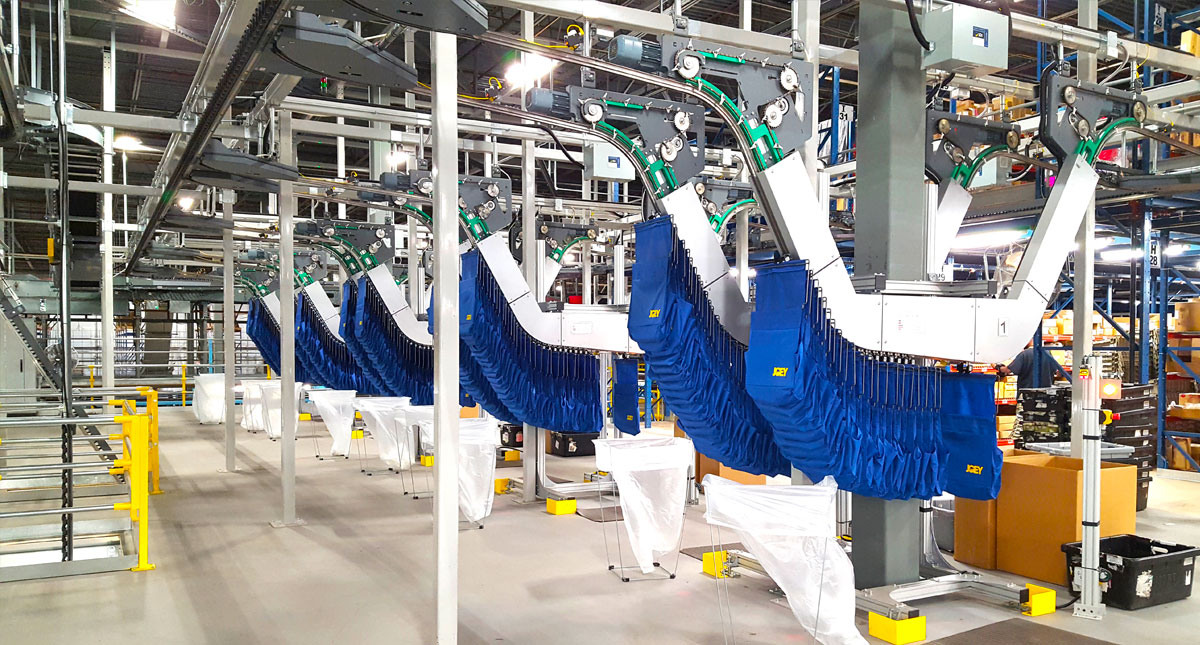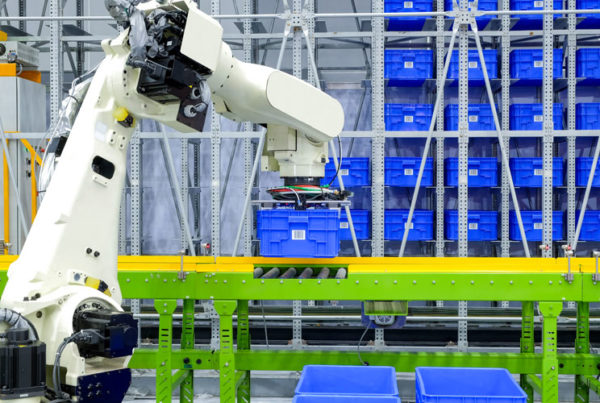As part of our series of webinars on automation and fulfillment, Bob Giberson, Principal at PeakLogix, sat down with Ross Halket, Vice President of Intralogistic Sales with Ferag (a WRH company). We wanted to ask Halket – who’s been in material handling for 40 years, and in automation for 30 of those years – about some of the international aspects of automation, and what he sees as the future of automation in fulfillment.
The exponential growth of materials handled today versus 40 years ago
40-years ago, says Halket, “When I first got into fulfillment and distribution, everything was moving pallets or moving cases, with a little bit of picking.”
But the Internet has changed things. Today, when we see something online we order it right then, and then we expect to get it as soon as tomorrow, or maybe even this afternoon. E-commerce companies have learned that people will keep shopping at their site only if they are given all of the choices they need and expect; a site has to be a one-stop shop for its customers, or the customers will take their business somewhere else.

Photo credit: Ferag
Halket recalls that, in the earlier days of the Internet, a consumer might order one piece, or one line, for fulfillment and that would be it.
Early e-commerce centers were designed to handle that kind of flow and pace. Today, however, the more SKUs a business offers, the more customer loyalty it earns. And more customer loyalty means more orders… which means more profit… which means adding even more SKUs to get even more customer loyalty…
This feedback loop snowballed until, quite suddenly, even small online retail stores began ordering more to expand their offerings. Where brick-and-mortar retailers used to order 20,000 to 30,000 SKUs, large, online retailers outpaced them and started keeping 1-2 million SKUs in their warehouses.
To handle the volume, you have to understand the pace and storage needs
The problems that warehousing all of these SKUs created in distribution centers, says Halket, are with the pace and storage. When you have 2,000,000 SKUs worth of inventory, you need a system capable of retrieving them on time and with accuracy.
Halket describes his first interaction with real innovation in Europe where European companies were driven largely by social issues to find creative solutions to handle their labor and safety requirements.
Europe was the first to develop storage engines that allowed them the flexibility needed to manage distribution centers operating 24-hours a day, 7-days a week. Innovation was created to replace off-shift, low wage jobs with more flexible, productive options, especially in places where labor shortages can halt operations.
“In Louisville, Kentucky,” Halket offers as an example, “Amazon has 8 or 9 distribution centers, each requiring 5,000 to 6,000 people.” Louisville’s a pretty big town – the city itself has maybe 600,000 people, and the metro area has nearly 1.3 million. Amazon wouldn’t have located there if it didn’t think it could find enough labor. “But now, they have absorbed so many workers that other companies in Louisville find themselves in a labor shortage. They can’t find enough workers, so they either have to leave Louisville, or find solutions that maximize the manpower they have.”
Data – and lots of it – is the key to finding these solutions. “The most successful systems,” says Halket, “tend to follow a pattern. First, we need to understand how much storage is required. Then, we need to know how fast we can get SKUs into that storage, and then back out of it.” It’s not one-size-fits-all; there are businesses that can find a small, relatively slow system that solves their labor problems and stays in their budget. And then there are the large companies, with seemingly unlimited capital to spend, that need big storage solutions and fast picking solutions.
It’s these two basic components – storage and velocity – that determine the kind of system a company needs.
From vertical lift modules to “the matrix”… and beyond
Some companies might find that a vertical lift module (VLM) – which can bring down, on average, 80 totes an hour – is all they need. Other companies move up to the miniload cranes that not only increase fulfillment to 130 totes an hour per crane, but they also allow the storage engine to go taller and longer.
“The next innovation,” Halket explains, “were carousel clusters, which use an extractor to get the totes out. If things are operating smoothly, carousel clusters might move 1,000 totes, in and out of storage, each hour. And then single level shuttles came along, which work in tandem with a miniload and get maybe 500-600 totes per aisle out of that system.”
Halket explains that until recently, these were the ultimate solutions. You would have a picking station in front of these storage engines, where you’d pick product from SKU totes and place it in an out-bound carton, which would travel to the shipping area then to the end buyer.
“But none of that is fast enough for the e-commerce holy grail to outbound a million units a day. To get to that, we have to employ what is called ‘the matrix.'” It’s a combination of systems that makes use of the x, y, and z axis in the storage area, moving SKUs up and down, back forth, and side to side, organizing picks before a person ever lays a hand on them.
Choice is a key element to successful innovations in fulfillment
Having access to all of these systems – with different storage densities and retrieval velocities – gives a company choice. As an integrator, offering the right choices to any client starts with the data. The first step is reviewing a company’s processes and systems to discover its true needs – analyzing the data gathered to recommend the right system that best meets their specific needs.
But even with existing systems in the market, there’s still room for improvement. “For example,” Halket explains, “we’re still doing a lot of discrete picking – sending a tote to a work station, putting one piece in it, and then moving to another work station, where another piece or maybe two get put in the tote, and then moving it out the door that way. We still do things that way because that system works. There are times when you need to pick discretely.”
“However,” he adds, “one benefit, that has yet to be fully exploited, is that they can now batch pick. So, if I know about orders two or three hours in advance, when the shuttle brings me a tote, I can pick out 15 items from it instead of one. Which increases my efficiency. I’m using fewer touches. And there’s less movement of the equipment, which means less wear and tear. I utilize my storage tote to its fullest, pick it clean, and move on to the next tote.”
But Halket breaks this process down further still. When he looks at what’s happening, he sees four people touching each package – and he sees that as an inefficiency. One person does the batch pick. It gets inducted into a sorter, which is another touch. It then goes to a put wall where someone takes it out of the tray so that someone on the other side can put it in the packaging.
“We’re looking at ways of cutting that down even more,” says Halket. An enthusiast for pouch sorters, Halket explains how they enable the company to pick from their storage engine and put the item in a pouch, which effectively becomes the put wall. This eliminates two touches. “If that doesn’t sound like much,” Halket adds, “remember that, for the companies who need this kind of optimization, we’re talking about moving a million or more items a day – so we’ve eliminated two million or more touches each day.”

Photo credit: Ferag
Tomorrow’s pickers, today
But even all of this innovation isn’t enough. The goal for many companies, according to Halket, is to have free-roaming robots that are doing the picking. “This is actually happening,” he says. “These autonomous robots are going down an aisle and doing what a human would do – picking items off a shelf or rack, putting them in a tote, and moving on.” They still have their limitations. According to Halket, however, the biggest businesses are so desperate for labor that they’re diving into these systems. They know they can’t afford to let their competitors get an edge on them with these technologies.
One benefit to these kinds of autonomous systems, which is often overlooked, is that you don’t have to install a bunch of infrastructure or fixed-material handling equipment. These autonomous robots can go down an existing aisle in a warehouse and operate in the same spaces that people do.
Change management is key to changing your fulfillment approach
As good as these systems are, there is still some risk in implementing them. “Change is painful for everybody,” Halket says, “so change management is key; the entire staff has to be primed and work in harmony to ensure this thing works.”
A common concern is the expense. Companies looking to implement automation often have to ask, “How can I afford this?” The answer isn’t easy.
“There will be a return on investment,” Halket promises. “But these things can’t be looked at with an old-school ROI mentality. Creating a system that can get your million SKUs out the door every single day… that’s a breed of animal that’s not going to come back in a one-year or a three-year ROI. When investing in these systems, it’s best to have an outlook that’s 4, 5, or even six years out – or sometimes even longer.”
“But it’s adapt or die. If you don’t find a way to afford this, you won’t need to worry about whether you’ll see that return on investment in two years or three – because your competitors, who did invest in these systems, will have taken away your market share.”
When experts like Halket think about how a company pays for these systems, they also think about what the company gets out of these systems. They look to improvements in one area that will either allow the company to cut back in other ways, or even add on. It’s SALT:
- Storage – These systems can get more SKUs in a limited space. Where before a company might have considered expanding their old warehouse or even relocating, these systems will allow the business to save those expenses, and redirect them into making the most out of their existing facilities. And that’s really what automation is all about – maximizing investments.
- Accuracy – Once these systems are implemented, a company can expect to see an accuracy of 99.99%. So, labor is saved in that people aren’t having to undo mistakes. Money is saved on returns and return shipping. And there is an improvement in customer loyalty. If you can get the customer what they expect to have, when they expect to have it, they’ll keep coming back.
- Labor – Automation helps labor in a number of ways. It can save your employees time and effort. It can maximize their efficiency. And, if labor simply isn’t available or is too expensive, automation provides a solution.
- Throughput –These systems can increase order cutoff times. But they don’t just move the product; they also handle it safely and package it in the right sequence. Almost all of the things people do, these systems can do – only faster and more accurately.
When we talk about risk and return on investment, the ideas are sometimes nebulous and hard to pin down. How, for example, do you equate the cost of a piece of equipment with a customer’s loyalty? That’s where having expert teams led by managers with 40-years of experience comes in. And, according to Halket – one of those experts with 40-years of experience – “That’s why we spend so much time up front, collecting all of the data we can about the company’s processes and business model, so that we can find the system that’s going to work for that business.
“But,” Halket warns, “if you look at SALT and your business is struggling with one of the issues, it’s time to start thinking about automation. And if your business is struggling with two – or even more – of these issues, you need to be investing in automation.”





